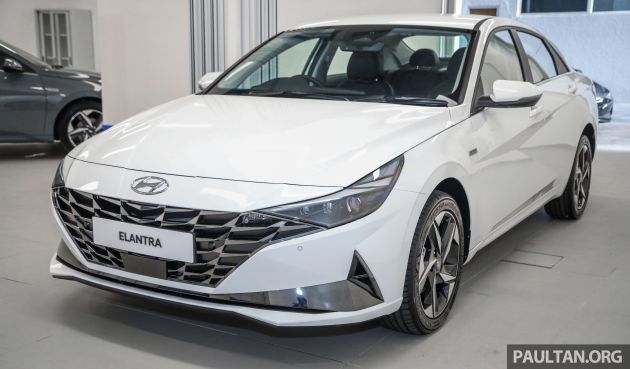2021 Hyundai Elantra launched in Malaysia – 7th-gen, single high-spec 1.6L IVT variant, CBU, RM158,888
The seventh-generation Hyundai Elantra has just been launched virtually by Hyundai-Sime Darby Motors (HSDM). Previewed last week, the CN7 Elantra arrives as a CBU import from South Korea, in a single 1.6L IVT variant, priced at an introductory RM158,888 on-the-road excluding insurance, with 2020 sales tax exemption. More on the specs and price later.
The new Elantra follows the Sensuous Sportiness design identity as per the new Sonata, but if the D-segment model is all about curves, the Elantra is full of sharp lines and triangles. Hyundai says that triangular shapes is a “taboo” in car design, and this is a bold attempt that achieves “geometrical beauty”. Definitely a love or hate design, but it’s certainly bold, and no one can accuse Hyundai of playing it safe and boring. The recently-revealed fourth-gen Tucson has the same Parametric Jewel design theme.
This sharply cut body is larger than the sixth-gen AD sedan it replaces. At 4,675 mm long, 1,825 mm wide and 1,430 mm tall, the CN7 is 55 mm longer and 25 mm wider than its predecessor, but 20 mm lower. Compared to the Honda Civic, the new Elantra is 27 mm longer, 26 mm wider and 14 mm taller, and its wheelbase is 20 mm longer than the Civic FC. Boot space is 474 litres (no spare tyre but a repair kit) versus the Honda’s 519 litres.
This car’s 2,720 mm wheelbase is 20 mm longer than the AD’s, which points to the new third-generation K3 modular global platform underneath, as used in the DN8 Sonata. The new architecture – which is said to improve safety, efficiency and driving performance – replaces the second-generation global platform family introduced in 2013.
Behind that low nose is a Smartstream G1.6 engine. This latest 1.6 litre unit is naturally aspirated and has dual port injection (MPI, as opposed to direct injection), pushing out 123 PS at 6,300 rpm and 154 Nm of torque at 4,500 rpm.
Also known as the “Gamma II” engine, the DOHC and Dual VVT unit is paired to Hyundai’s Intelligent Variable Transmission (IVT) with eight virtual speeds. IVT is the carmaker’s in-house developed and produced CVT, with a chain-belt promising better response and the shift pattern of a manual transmission. This would be the first Hyundai sold here with a stepless automatic – we’ve had torque converter and dual-clutch ATs before.
The Smartstream engine and gearbox combo powers the 1,245 kg Elantra from 0-100 km/h in 10.4 seconds, while top speed is 196 km/h. The in-house claimed combined fuel consumption figure is 5.6 litres per 100 km, or 17.85 km/l. In terms of performance, it’s not quite at the level of the previous-gen AD Turbo, or even the Civic FC’s 1.5T engine (173 PS/220 Nm), but Hyundai does have the Elantra N Line with a 201 hp/264 Nm 1.6L turbo engine. Is that one in the plans, HSDM?
As for the chassis, it’s front MacPherson struts and rear torsion beam suspension. Brakes are ventilated discs in front and solid discs at the back. Electric power steering (EPS, or MDPS in Hyundai-speak) and an electronic parking brake with auto hold are also in the mix.
As you would have noticed by now, this C-segment contender is more about design and features than outright performance (there’s absolutely nothing wrong with that), and the single CBU variant that Malaysia gets is very well equipped indeed.
On the outside, you’ll find bi-LED headlamps, LED daytime running lights, full-width LED tail lamps (forms a wide H) and 17-inch two-tone alloys (225/45 Kumho Ecsta PS71 tyres) that match the car’s parametric design. Note that these are factory wheels and not locally-sourced items – speaking of that, the only local addition to the CN7 are “Smartstream” emblems on the front wings.
The new Elantra’s “immersive cocoon” interior matches the wow factor of the exterior, even if it’s not as sharply cut. There’s a very prominent boundary between the driver’s cockpit area and the front passenger, brought about by a physical barrier that slopes down from the dashboard to the centre armrest, and trim colour.
The horizontal vents made popular by Audi is employed in this driver-centric cabin, and above that strip are screens for the instrument panel and infotainment system.
The instrument panel is a 10.25-inch Supervision LCD colour display (dials will change colour according to drive mode), while the head unit is an 8.0-inch unit touchscreen with Android Auto and Apple CarPlay. There’s also a Bluetooth multi-connection function that will take music from one phone, and calls from another. Wireless smartphone charger too, of course.
Other useful comfort and convenience features include ventilated/heated front seats, heated steering wheel (we don’t need it, but these kit come in a package), dual-zone auto air con with three step auto blower control, rear AC vents, smart temperature control for the driver’s seat (seat ventilation can be synced with climate control), electronic parking brake with auto hold, tyre pressure monitoring and a hands-free smart boot (no gestures needed, just wait).
Also included are an eight-way powered driver’s seat with lumbar, keyless entry and push start, auto headlamps and wipers and multi-angle reverse camera. The front cupholders are variable and can fit a various drink sizes.
While we only get one variant, there are two interior colour schemes, which is all black and light grey. Black is self-explanatory, but the grey scheme is nice as it highlights the cockpit zone with an all-round grey border. It also comes with a nice grey fabric on the door cards that looks and feels nicer than the black leather. The melange-style fabric (my description, not Hyundai’s) is also found on the back of the front seats.
Both themes come with leather seats – choose the black theme and you’ll get black seats, vice versa. We salute HSDM for giving a non-black cabin option – Malaysian car buyers are a conservative lot, as all carmakers will tell you, so no one would bat an eyelid if black was the only choice. As for exterior colours, the Elantra will be shipped here in Polar White, Amazon Grey, Electric Shadow and Intense Blue. The Electric Shadow seen here is Hyundai’s take on the currently trendy “Nardo Grey” hue.
Last but definitely not least is safety, and the Elantra is strong in this department. Hyundai’s full and latest SmartSense suite of driver assist features are present. In the pack are Lane Keeping Assist (LKA), Lane Following Assist (LFA), Smart Cruise Control (SCC) with Stop & Go, Forward Collision Avoidance Assist (FCA), Forward Collision Assist Junction, Blind Spot Collision with Avoidance Assist, Rear Cross Traffic Collision (RCCA) with Avoidance Assist, Safe Exit Warning, Driver Attention Warning (DAW), Leading Vehicle Departure Alert (LVDA) and Rear Occupant Alert.


The basic SmartSense features are familiar, but there are new functions such as LFA (keeps one in the centre of the lane), cyclist detection for the FCA, junction FCA, Stop & Go for the SCC (car will move again from a standstill), and Avoidance Assist for the blind spot monitor and RCTA (stops the car instead of just warning you), among other things. LVDA is like Perodua ASA’s front departure alert. All that is in addition to six airbags and two rear Isofix child seat mounts.
OK, with all the ingredients covered, let’s talk about the price, which is RM158,888 OTR excluding insurance, with 2020 sales tax exemptions (described as introductory, it should go up next year). Being a CBU Korea entry with such high specs, we’re not at all surprised at the Elantra’s price, which is higher than the Toyota Corolla and Honda Civic. It’s close to the CBU Japan Mazda 3, which tops out at RM154,679 after SST exemption. Hyundai’s factory warranty is for five years or 300,000 km.
Clearly not the cheapest C-segment sedan around then, but the CN7 Hyundai Elantra looks like nothing else on the road, at least until the next-gen Tucson arrives. What do you think of the new Elantra?
GALLERY: 2021 Hyundai Elantra 1.6L IVT, Malaysia-spec 







































































































The post 2021 Hyundai Elantra launched in Malaysia – 7th-gen, single high-spec 1.6L IVT variant, CBU, RM158,888 appeared first on Paul Tan's Automotive News.
from Paul Tan's Automotive News
Read The Rest:paultan...







Post a Comment